trailer Peugeot 308 CC 2011 Owner's Manual - RHD (UK, Australia)
[x] Cancel search | Manufacturer: PEUGEOT, Model Year: 2011, Model line: 308 CC, Model: Peugeot 308 CC 2011Pages: 292, PDF Size: 38.8 MB
Page 5 of 292
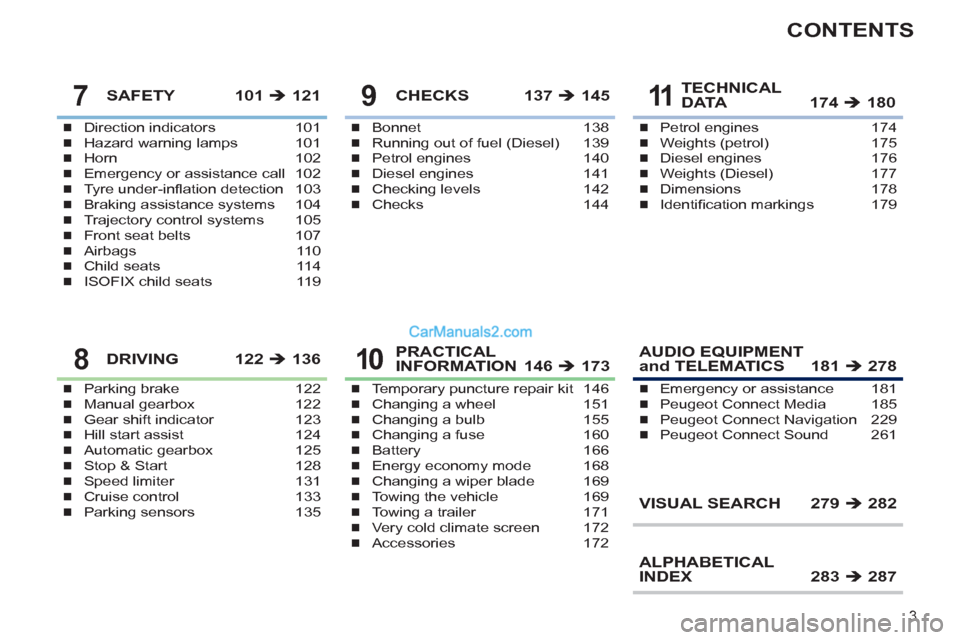
3
CONTENTS
Direction indicators 101
Hazard warning lamps 101
Horn 102
Emergency or assistance call 102
Tyre under-infl ation detection 103
Braking assistance systems 104
Trajectory control systems 105
Front seat belts 107
Airbags 110
Child seats 114
ISOFIX child seats 119�„
�„
�„
�„
�„
�„
�„
�„
�„
�„
�„
SAFETY 101 �Π121
Parking brake 122
Manual gearbox 122
Gear shift indicator 123
Hill start assist 124
Automatic gearbox 125
Stop & Start 128
Speed limiter 131
Cruise control 133
Parking sensors 135�„
�„
�„
�„
�„
�„
�„
�„
�„
DRIVING 122 �Π136
Bonnet 138
Running out of fuel (Diesel) 139
Petrol engines 140
Diesel engines 141
Checking levels 142
Checks 144�„
�„
�„
�„
�„
�„
CHECKS 137 �Π145
Temporary puncture repair kit 146
Changing a wheel 151
Changing a bulb 155
Changing a fuse 160
Battery 166
Energy economy mode 168
Changing a wiper blade 169
Towing the vehicle 169
Towing a trailer 171
Very cold climate screen 172
Accessories 172�„
�„
�„
�„
�„
�„
�„
�„
�„
�„
�„
PRACTICAL
INFORMATION 146 �Π173
Petrol engines 174
Weights (petrol) 175
Diesel engines 176
Weights (Diesel) 177
Dimensions 178
Identifi cation markings 179�„
�„
�„
�„
�„
�„
TECHNICAL
DATA 174 �Π180
AUDIO EQUIPMENT
and TELEMATICS 181 �Π278
VISUAL SEARCH 279 �Π282
ALPHABETICAL
INDEX 283 �Π287
Emergency or assistance 181
Peugeot Connect Media 185
Peugeot Connect Navigation 229
Peugeot Connect Sound 261�„
�„
�„
�„
7
89
1011
Page 23 of 292
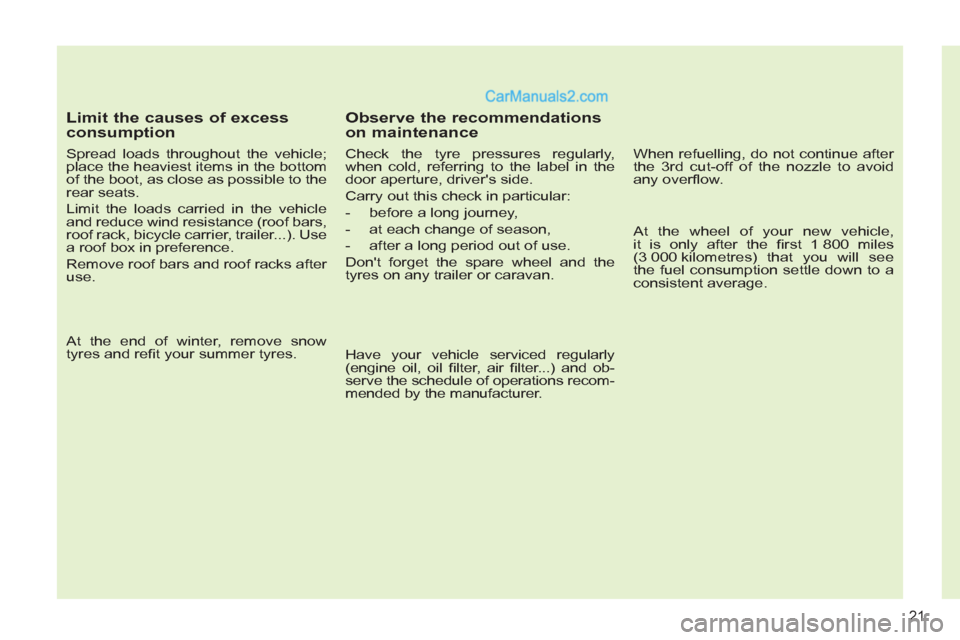
21
Limit the causes of excess
consumption
Spread loads throughout the vehicle;
place the heaviest items in the bottom
of the boot, as close as possible to the
rear seats.
Limit the loads carried in the vehicle
and reduce wind resistance (roof bars,
roof rack, bicycle carrier, trailer...). Use
a roof box in preference.
Remove roof bars and roof racks after
use.
At the end of winter, remove snow
tyres and refi t your summer tyres.
Observe the recommendations
on maintenance
Check the tyre pressures regularly,
when cold, referring to the label in the
door aperture, driver's side.
Carry out this check in particular:
- before a long journey,
- at each change of season,
- after a long period out of use.
Don't forget the spare wheel and the
tyres on any trailer or caravan.
Have your vehicle serviced regularly
(engine oil, oil fi lter, air fi lter...) and ob-
serve the schedule of operations recom-
mended by the manufacturer.
When refuelling, do not continue after
the 3 rd cut-off of the nozzle to avoid
any overfl ow.
At the wheel of your new vehicle,
it is only after the fi rst 1 800 miles
(3 000 kilometres) that you will see
the fuel consumption settle down to a
consistent average.
Page 138 of 292
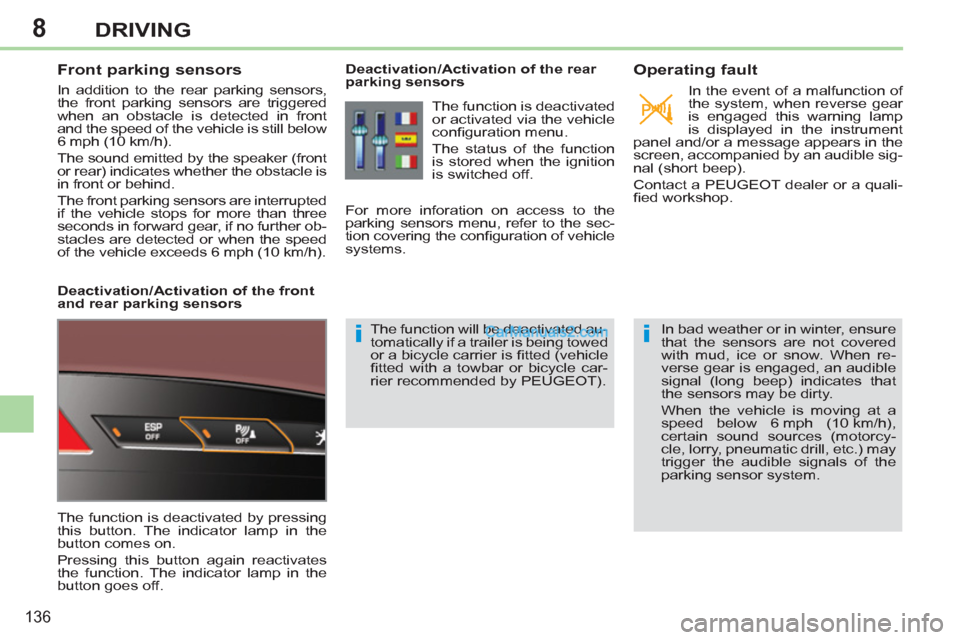
8
ii
136
DRIVING
Front parking sensors
In addition to the rear parking sensors,
the front parking sensors are triggered
when an obstacle is detected in front
and the speed of the vehicle is still below
6 mph (10 km/h).
The sound emitted by the speaker (front
or rear) indicates whether the obstacle is
in front or behind.
The front parking sensors are interrupted
if the vehicle stops for more than three
seconds in forward gear, if no further ob-
stacles are detected or when the speed
of the vehicle exceeds 6 mph (10 km/h).
Deactivation/Activation of the front
and rear parking sensors
The function is deactivated by pressing
this button. The indicator lamp in the
button comes on.
Pressing this button again reactivates
the function. The indicator lamp in the
button goes off.
Deactivation/Activation of the rear
parking sensors
The function will be deactivated au-
tomatically if a trailer is being towed
or a bicycle carrier is fi tted (vehicle
fi tted with a towbar or bicycle car-
rier recommended by PEUGEOT).
Operating fault
In the event of a malfunction of
the system, when reverse gear
is engaged this warning lamp
is displayed in the instrument
panel and/or a message appears in the
screen, accompanied by an audible sig-
nal (short beep).
Contact a PEUGEOT dealer or a quali-
fi ed workshop.
In bad weather or in winter, ensure
that the sensors are not covered
with mud, ice or snow. When re-
verse gear is engaged, an audible
signal (long beep) indicates that
the sensors may be dirty.
When the vehicle is moving at a
speed below 6 mph (10 km/h),
certain sound sources (motorcy-
cle, lorry, pneumatic drill, etc.) may
trigger the audible signals of the
parking sensor system.
The function is deactivated
or activated via the vehicle
confi guration menu.
The status of the function
is stored when the ignition
is switched off.
For more inforation on access to the
parking sensors menu, refer to the sec-
tion covering the confi guration of vehicle
systems.
Page 164 of 292
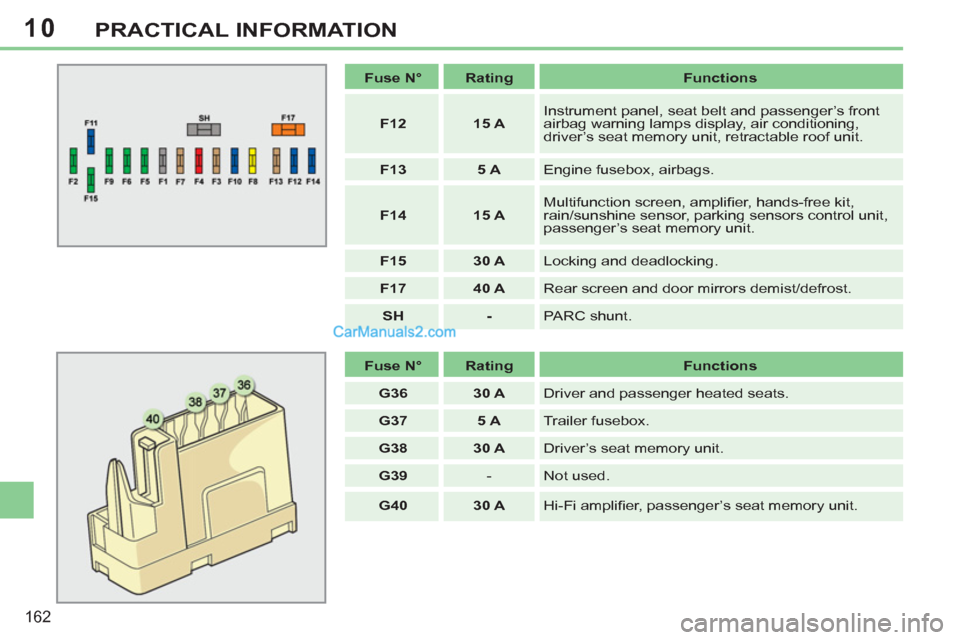
10
162
PRACTICAL INFORMATION
Fuse N°
Rating
Functions
F12
15 A
Instrument panel, seat belt and passenger’s front
airbag warning lamps display, air conditioning,
driver’s seat memory unit, retractable roof unit.
F13
5 A
Engine fusebox, airbags.
F14
15 A
Multifunction screen, amplifi er, hands-free kit,
rain/sunshine sensor, parking sensors control unit,
passenger’s seat memory unit.
F15
30 A
Locking and deadlocking.
F17
40 A
Rear screen and door mirrors demist/defrost.
SH
-
PARC shunt.
Fuse N°
Rating
Functions
G36
30 A
Driver and passenger heated seats.
G37
5 A
Trailer fusebox.
G38
30 A
Driver’s seat memory unit.
G39
- Not used.
G40
30 A
Hi-Fi amplifi er, passenger’s seat memory unit.
Page 173 of 292
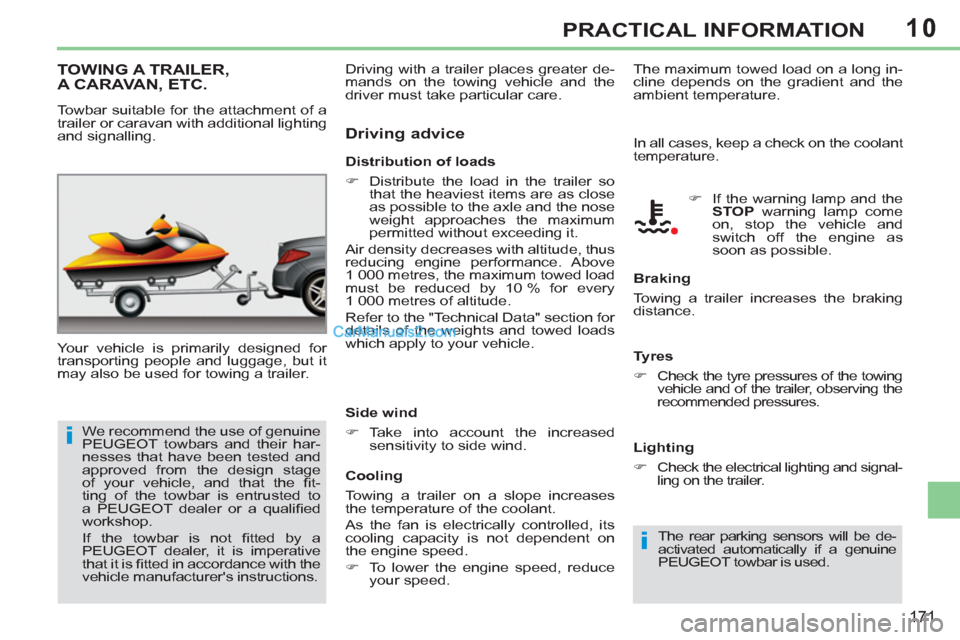
10
i
i
171
PRACTICAL INFORMATION
TOWING A TRAILER,
A CARAVAN, ETC.
Your vehicle is primarily designed for
transporting people and luggage, but it
may also be used for towing a trailer.
Distribution of loads
�)
Distribute the load in the trailer so
that the heaviest items are as close
as possible to the axle and the nose
weight approaches the maximum
permitted without exceeding it.
Air density decreases with altitude, thus
reducing engine performance. Above
1 000 metres, the maximum towed load
must be reduced by 10 % for every
1 000 metres of altitude.
Refer to the "Technical Data" section for
details of the weights and towed loads
which apply to your vehicle.
Side wind
�)
Take into account the increased
sensitivity to side wind.
Cooling
Towing a trailer on a slope increases
the temperature of the coolant.
As the fan is electrically controlled, its
cooling capacity is not dependent on
the engine speed.
�)
To lower the engine speed, reduce
your speed.
Towbar suitable for the attachment of a
trailer or caravan with additional lighting
and signalling.
Driving advice
We recommend the use of genuine
PEUGEOT towbars and their har-
nesses that have been tested and
approved from the design stage
of your vehicle, and that the fi t-
ting of the towbar is entrusted to
a PEUGEOT dealer or a qualifi ed
workshop.
If the towbar is not fi tted by a
PEUGEOT dealer, it is imperative
that it is fi tted in accordance with the
vehicle manufacturer's instructions. Driving with a trailer places greater de-
mands on the towing vehicle and the
driver must take particular care.
In all cases, keep a check on the coolant
temperature.
Braking
Towing a trailer increases the braking
distance.
Tyres
�)
Check the tyre pressures of the towing
vehicle and of the trailer, observing the
recommended pressures.
Lighting
�)
Check the electrical lighting and signal-
ling on the trailer.
The rear parking sensors will be de-
activated automatically if a genuine
PEUGEOT towbar is used.
�)
If the warning lamp and the
STOP
warning lamp come
on, stop the vehicle and
switch off the engine as
soon as possible.
The maximum towed load on a long in-
cline depends on the gradient and the
ambient temperature.
Page 177 of 292
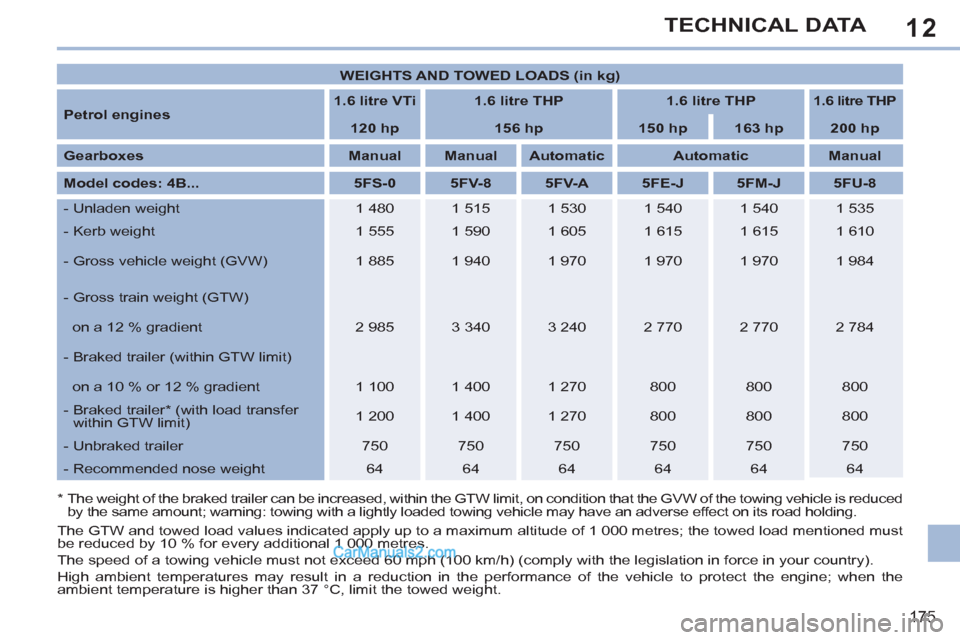
12
175
TECHNICAL DATA
*
The weight of the braked trailer can be increased, within the GTW limit, on condition that the GVW of the towing vehicle is reduced
by the same amount; warning: towing with a lightly loaded towing vehicle may have an adverse effect on its road holding.
The GTW and towed load values indicated apply up to a maximum altitude of 1 000 metres; the towed load mentioned must
be reduced by 10 % for every additional 1 000 metres.
The speed of a towing vehicle must not exceed 60 mph (100 km/h) (comply with the legislation in force in your country).
High ambient temperatures may result in a reduction in the performance of the vehicle to protect the engine; when the
ambient temperature is higher than 37 °C, limit the towed weight.
WEIGHTS AND TOWED LOADS (in kg)
Petrol engines
1.6 litre VTi
1.6 litre THP
1.6 litre THP
1.6 litre THP
120 hp
156 hp
150 hp
163 hp
200 hp
Gearboxes
Manual
Manual
Automatic
Automatic
Manual
Model codes: 4B...
5FS-0
5FV-8
5FV-A
5FE-J
5FM-J
5FU-8
- Unladen weight
1 480
1 515
1 530
1 540
1 540
1 535
- Kerb weight
1 555
1 590
1 605
1 615
1 615
1 610
- Gross vehicle weight (GVW)
1 885
1 940
1 970
1 970
1 970
1 984
- Gross train weight (GTW)
on a 12 % gradient
2 985
3 340
3 240
2 770
2 770
2 784
- Braked trailer (within GTW limit)
on a 10 % or 12 % gradient
1 100
1 400
1 270
800
800
800
- Braked trailer * (with load transfer
within GTW limit)
1 200
1 400
1 270
800
800
800
- Unbraked trailer
750
750
750
750
750
750
- Recommended nose weight
64
64
64
64
64
64
Page 179 of 292
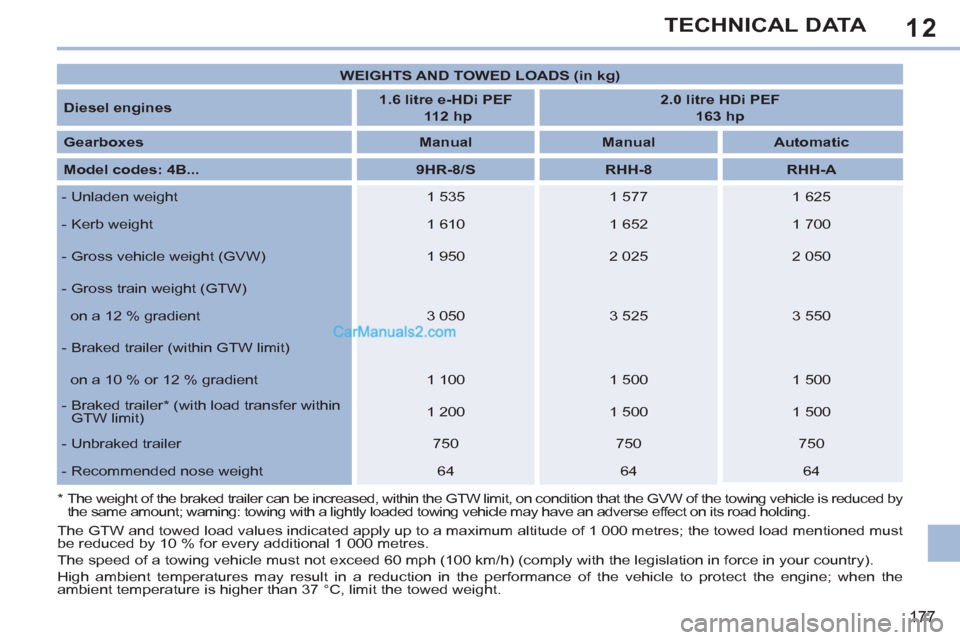
12
177
TECHNICAL DATA
*
The weight of the braked trailer can be increased, within the GTW limit, on condition that the GVW of the towing vehicle is reduced by
the same amount; warning: towing with a lightly loaded towing vehicle may have an adverse effect on its road holding.
WEIGHTS AND TOWED LOADS (in kg)
Diesel engines
1.6 litre e-HDi PEF
112 hp
2.0 litre HDi PEF
163 hp
Gearboxes
Manual
Manual
Automatic
Model codes: 4B...
9HR-8/S
RHH-8
RHH-A
- Unladen weight
1 535
1 577
1 625
- Kerb weight
1 610
1 652
1 700
- Gross vehicle weight (GVW)
1 950
2 025
2 050
- Gross train weight (GTW)
on a 12 % gradient
3 050
3 525
3 550
- Braked trailer (within GTW limit)
on a 10 % or 12 % gradient
1 100
1 500
1 500
- Braked trailer * (with load transfer within
GTW limit)
1 200
1 500
1 500
- Unbraked trailer
750
750
750
- Recommended nose weight
64
64
64
The GTW and towed load values indicated apply up to a maximum altitude of 1 000 metres; the towed load mentioned must
be reduced by 10 % for every additional 1 000 metres.
The speed of a towing vehicle must not exceed 60 mph (100 km/h) (comply with the legislation in force in your country).
High ambient temperatures may result in a reduction in the performance of the vehicle to protect the engine; when the
ambient temperature is higher than 37 °C, limit the towed weight.